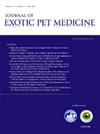确定东领蜥血浆视黄醇参考区间
IF 0.6
4区 农林科学
Q4 VETERINARY SCIENCES
引用次数: 0
摘要
背景东领蜥(Crotaphytus collaris)是一种原产于美国和墨西哥的蜥蜴,在世界各地的外来物种中越来越受欢迎。关于这种蜥蜴或其近亲物种的分析物分解,目前所知甚少。随着该物种在外来物种界越来越受欢迎,越来越多的医疗状况被发现,通过确定不同基本分析物的范围可以帮助诊断。作为一种食虫蜥蜴,该物种可能患有维生素 A 不足症。一直以来,缺乏可用于该疾病微创和适当诊断的死前诊断方法。最近对其他小型食虫动物物种进行的研究确定了血浆视黄醇参考区间。方法使用超高效液相色谱-串联质谱法(UPLC-MS/MS)对 40 只临床健康的人工饲养的东方领蜥(20 只雄性和 20 只雌性)的血浆进行分析,测定血浆中视黄醇的浓度。结果使用超高效液相色谱-质谱/质谱分析,数据呈正态分布,东领蜥血浆视黄醇的参考区间为 1.57-3.07 µg/mL (0.237-0.464 µmol/L)。平均值为 0.31 微克/毫升;下限 95% 置信区间为 1.34-1.80 微克/毫升,上限为 2.84-3.30 微克/毫升。在人工繁殖的 "炽蓝 "品系(n = 4)与所有其他人工繁殖的采样地点相比,维生素 A(视黄醇)水平存在显著差异。包括密切相关的水焰(n = 16)、(天蓝)(n = 2)、西部黄头鱼(n = 5)、花式斑点鱼(n = 4)、水蓝(n = 3)和闪电黄(n = 6);在假设等量变化的情况下,通过 t 检验比较,炽热蓝形态的维生素 A(视黄醇)含量明显较低。在年龄组中,只有 1 岁和 6 岁年龄组之间存在统计差异,6 岁年龄组明显低于 1 岁年龄组。本研究首次确定了鬣蜥亚目物种的血浆视黄醇范围。这些数值有助于诊断和治疗维生素 A 缺乏症,并为领蜥以及其他相关物种提供饮食补充和饮食改善建议。此外,这些数值还可用于设计和评估有关该物种营养需求的其他研究。这项研究的局限性包括:只收集了一个季节的数据,没有与肝脏数值进行同期比较,某些年龄组的数据仅限于 1 个个体,而且只对人工饲养的个体进行了评估。本文章由计算机程序翻译,如有差异,请以英文原文为准。
Determination of a plasma retinol reference interval in eastern collared lizards (Crotaphytus collaris)
Background
The Eastern collared lizard (Crotaphytus collaris) is a species of lizard native to the United States and Mexico and is growing in popularity in the exotic community around the world. There is minimal knowledge known on the analyte breakdown of this or closely related species. As this species becomes more popular in the exotic community more medical conditions are being identified that can be assisted in diagnosis with the establishment of ranges of the different essential analytes. Being an insectivorous lizard, this species may suffer from hypovitaminosis A. There has been a lack of antemortem diagnostics available for minimally invasive and appropriate diagnosis of this disease. Recent studies have been performed in other small insectivore species establishing plasma retinol reference intervals. Reference intervals for retinol have not been published or validated in collared lizards or any closely related species.
Methods
Plasma, with a sample volume of only 50 µl, from forty clinically healthy captive bred Eastern collared lizards, twenty males and twenty females were analyzed using ultra-high-performance liquid chromatography with tandem mass spectrometry (UPLC-MS/MS) to determine plasma retinol concentrations.
Results
Using UPLC-MS/MS analysis, data was normally distributed and a reference interval for plasma retinol in the Eastern collared lizard was 1.57-3.07 µg/mL (0.237-0.464 µmol/L). A mean of 0.31µg/mL; with a lower limit 95% confidence interval being 1.34-1.80 µg/mL and upper limit of 2.84-3.30 µg/mL. Vitamin A (retinol) levels were significantly different when comparing a captive bred line called Blazing Blue (n = 4), with all other sampled captive bred localities. Including a closely related Aquaflames (n = 16), (Sky Blue) (n = 2), Western yellowhead (n = 5), Fancy Spotted (n = 4), Aquamarine (n = 3), and Lightning Yellow (n = 6); with the Blazing Blue morph being significantly lower using a t-Test comparison assuming equal variations. There was only 1 statistical variation seen in age groups between the 1-year-old and 6-year-old age groups with the 6-year-old age group being significantly lower than the 1-year-old age group. There was no variation based on sex.
Conclusions and clinical relevance
This study provides the first established plasma retinol range in a species in the suborder iguania. Values are valuable in assistance in diagnosing and treating hypovitaminosis A and to provide advice on dietary supplementation and dietary improvement for the collared lizards and possibly other related species as well. In addition, these values can be used to design and evaluate other studies for nutritional needs of this species. Limitations of this study include only a single season of collection, no same time comparison to liver values, some age groups were limited to only 1 individual, and the evaluation of only captive bred individuals.
求助全文
通过发布文献求助,成功后即可免费获取论文全文。
去求助
来源期刊

Journal of Exotic Pet Medicine
农林科学-兽医学
CiteScore
1.20
自引率
0.00%
发文量
65
审稿时长
60 days
期刊介绍:
The Journal of Exotic Pet Medicine provides clinicians with a convenient, comprehensive, "must have" resource to enhance and elevate their expertise with exotic pet medicine. Each issue contains wide ranging peer-reviewed articles that cover many of the current and novel topics important to clinicians caring for exotic pets. Diagnostic challenges, consensus articles and selected review articles are also included to help keep veterinarians up to date on issues affecting their practice. In addition, the Journal of Exotic Pet Medicine serves as the official publication of both the Association of Exotic Mammal Veterinarians (AEMV) and the European Association of Avian Veterinarians (EAAV). The Journal of Exotic Pet Medicine is the most complete resource for practitioners who treat exotic pets.
 求助内容:
求助内容: 应助结果提醒方式:
应助结果提醒方式:


